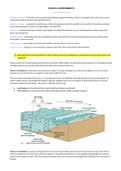Summary
Summary CIE International Geography A2 level (Advanced Physical Options - coastal environments).
- Institution
- CIE
CIE International Geography A2 level (Advanced Physical Options - coastal environments). With these notes you'll have the necessary material to get an A+.
[Show more]




